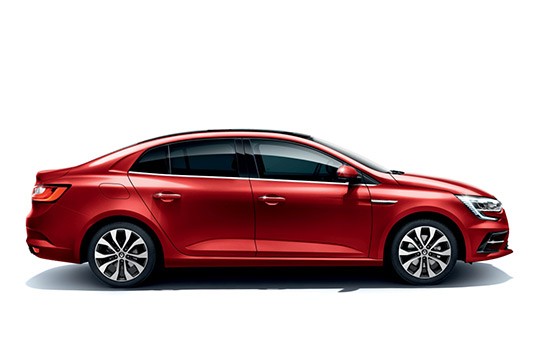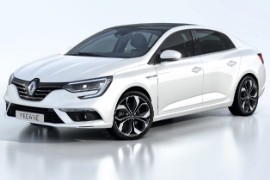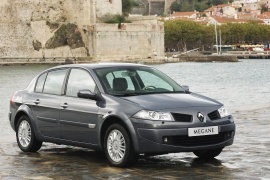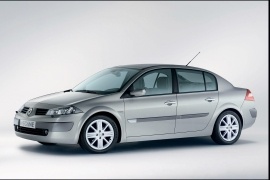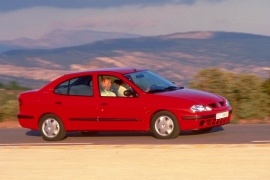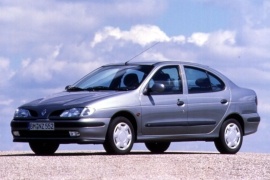RENAULT Megane Sedan Models/Series Timeline, Specifications & Photos
First production year: 1996
Engines: Gasoline, Diesel
Designed as a four-door coupe, but with a reasonable price, the Renault Megane sedan received a facelift in 2020 to prepare it for the 2021 pollution norms.
The French carmaker introduced the Megane sedan in 2016, and it sold it in more than 200.000 units since then. It was part of the Megane lineup, which also comprised the 3-door, the 5-door, and the station wagon. Starting with January 2021, all new cars registered in the EU had to comply with the Euro 6d regulations.
Since they had to work on the engines and four years already passed since the car was introduced to the market, Renault decided to work on a facelifted version. For the 2020 model, the LED technology was integrated into the car's headlights along with the light-strip for the DRL. The front bumper was reshaped as well, and it featured a more aggressive style with fake side-scoops in the apron and a lower grille with four slats. Another change was the addition of two chromed, fake exhausts under the rear bumper.
Inside, the driver was welcomed by a completely new 10.2" digital instrument panel, which integrated the navigation system along with the other dials needed for regular driving. Next to it, Renault installed a 9.3" multimedia on the center stack system named Easy Link.
Renault offered the Megane Sedan with a 1.0-liter turbocharged gasoline engine as a base model for the drivetrain, which offered 115 hp. The top of the line 1.3-liter four-pot provided 140 hp. For the diesel fans, the French carmaker installed a 1.5-liter dCi powerplant that offered 115 hp. All three engines were paired as standard to a 6-speed manual, while the last two could have been mated to a 7-speed automatic (dual-clutch) gearbox.
Renault brought back the Sedan version for its compact-segment contender Megane in 2016, replacing the former, ill-fated Fluence.
While in some European countries, hatchbacks were much more appreciated than sedans, in the compact segment, other customers asked for four-door vehicles since they seemed to be more appropriate for family use and provided larger trunks than their five-door siblings. But Renault had an even better idea.
The design team had a difficult task when making the Megane Sedan since it was asked to pen the vehicle so that it would resemble a four-door coupe. That's why, apart from the front fascia common with the hatchbacks, the rest of the car was different, at least from the B-pillar rearwards. In addition, the sloped rear windscreen and the tall trunk lid made the vehicle look like a coupe. Unfortunately, the bean counters decided against hidden door handles, resulting in a regular sedan with a taller trunk. Still, the rear taillights looked very nice with their elongated and slim design.
Inside, Renault offered the vehicle a choice of trims. It started with a mundane fabric upholstery made from recycled plastic and went up to much better materials. Also, while the base model featured just a bland stereo and manual AC mounted on the center stack, the upper trim levels received an infotainment system with a portrait touchscreen. But at least all versions featured Bluetooth connectivity for calls.
Under the hood, Renault placed a wide range of gasoline and turbo-diesel engines. The least-powered version received a naturally-aspirated 1.6-liter powerplant, while the most potent version was the 130 PS (128 HP) turbo-diesel.
Renault introduced a facelift for Megane's second generation in 2006 and added new engines and an enhanced exterior.
The second generation of the Megane was a big success, and the carmaker tried to keep that trend going. Renault improved the safety systems, the car's look, and its powerplants for the facelifted version. The sedan version was very successful on the East European market and deserved notable credits for Megane's sales results.
By 2006, Renault had a new front fascia design concept, and it applied it to the entire range. Depending on the trim level, it featured black or body-colored moldings on the bumper and the sides, protecting the paint from minor bumps or door scratches in the parking lot. It used the same angular shape for the headlights but with new lamps and projectors. On the lower side of the front bumper, the carmaker installed round fog lights as standard for the entire range.
The interior showed a new navigation system designed together with TomTom. Its retractable screen on top of the dashboard was unique on the market, at least on the budget car segment. For the lower trim levels, the Megane featured standard air-conditioning and a decent CD radio.
Under the hood, Renault installed a choice of seven engines. Depending on the market, it offered a choice of manual or automatic gearboxes.
Renault introduced the second generation of the Megane in 2003, and it already knew what the market asked for a budget-car, and which were the customers' expectations from it.
The French carmaker built its compact segment contender in four shapes: hatchback with three and five doors, sedan, station wagon, and coupe cabriolet. The three-box version was designed especially for families and fleets.
Megane's second generation showed a clear understanding of the new-edge design trend. At the front, the angular and angled headlights were continued with a black grille in a wide V-shaped line. In the middle, Renault's rhomboidal badge matched the car's lines. With its clear edges across the hood and raked windshield, the Megane Sedan managed to be not too bold and not too bald either. The wide C-pillar and the curved rear windscreen created a fluid line toward the flat and straight trunk lid in the back. Its corner-mounted taillights were a cost-effective solution.
Inside, Renault managed to offer decent room for four people by limiting the front seats front and back travel. Thus, the driers taller than 1.90 m (6.2') had difficulties in finding a driving position. But since the average European size was around 1.75 m (5.7'), the carmaker didn't see that as a problem. Unlike most other carmakers on the market, Renault offered a keyless entry and start system with an RF card, which had to be pushed in a slot at the bottom of the center stack.
Under the hood, Renault installed powerplants ranged between 82 hp and 135 hp, both gasoline or turbo-diesel. Depending on the version, the carmaker paired them with a five or six-speed manual, while a four-speed automatic was available for selected engines.
Three years after the introduction of the Megane Sedan, the French automaker upgraded the entire lineup, preparing it for the Euro3 emission standards.
The Megane was a huge success for Renault. It replaced more cars at once and was available in all bodyworks, from a sporty coupe to a family-oriented MPV, the Megane Scenic. Although along with the facelift, the latter version became a separate lineup, the rest of the range still bore the Megane nameplate. The Sedan model was mainly developed for East-European customers since they considered sedans serious family vehicles, not hatchbacks.
In 1999, the refreshed version received a new front fascia with a split grille incorporated into the hood. It featured the bird-beak design theme that placed a vertical slat in the middle, sporting the carmaker's logo. From its profile, the curved lines resembled the bio-design era about to disappear. Yet the French automaker didn't consider it outdated. At the back, the tall trunk lid kept the same shape as the non-facelifted version but added smoked taillights.
Inside, the Megane Sedan still offered plenty of hard plastic areas. On the other hand, customers couldn't complain since they knew that they paid pennies for such a vehicle. The entire range received AC units. Moreover, even though the rear doors featured cranked windows, the automaker offered powered ones as an option. The upholstery was not very sophisticated, but it was sturdy.
Under the hood, Renault dropped the former Euro 2-compliant engines and installed only Euro 3 ones. They ranged between 65 ps (64 HP) and 115 ps (113 HP).
Renault introduced the Megane lineup as a replacement for the model 19 in 1995 as a hatchback and the sedan version in 1996.
The French carmaker was not completely ready to give up on its former Renault 19 Chamade (three-box sedan version) and kept it on the production lines in Turkey, but its sales were limited to specific countries. Meanwhile, the Megane Sedan began its career. While the hatchback version was the standard for the compact segment, many customers considered the sedan shape as an upmarket product and asked for it.
Patrick le Quement was in charge of Renault's design department when he approved the Megane project in 1991. He insisted on keeping the "bird beak" front fascia as a signature for the carmaker. Even the headlights followed a bird-eye shape. The car featured the same front windshield but a different shape after the B-pillar. A flat trunk lid continued its rounded greenhouse and raked-forward windscreen.
Inside, Renault installed a low-budget interior for the vehicles built in Turkey and better materials for those produced in France. The rounded dashboard design sported oval vents and a wide instrument cluster extended above the center stack. On the base trim level, it featured cranked windows, with an option for power-operated ones.
Like the rest of the Megane range, the Megane sedan shared most of its engines with the Renault 19. Later on, the carmaker added new versions either more fuel-efficient or more powerful.
